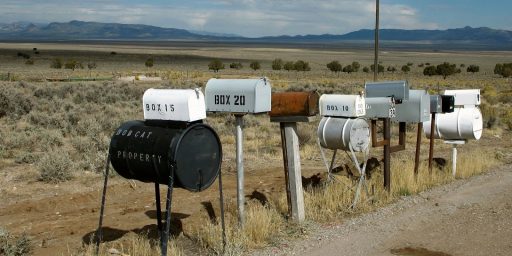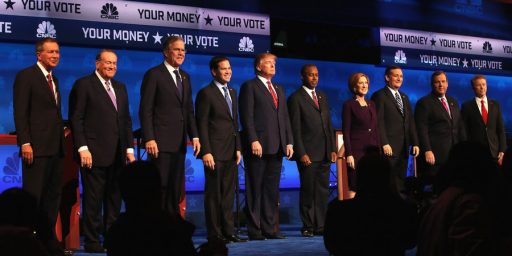Presidential Campaign Down to Six States
The Electoral College is once again having the opposite effect of what its defenders claim.

After two elections in recent memory in which the candidate who got the most votes for President lost the election, we’ve quite reasonably had more scrutiny of the Electoral College system. The main argument used by defenders is that it forces candidates who want to lead the country to pay attention to voters in smaller states and rural areas, not just those who live in the big cities. Once again, though, the reality is quite different.
NPR‘s Domenico Montanaro (“Biden Is Outspending Trump On TV, And Just 6 States Are The Focus Of The Campaign“):
Where the major party presidential campaigns are spending their money on TV advertising can tell you a lot about where they’re focusing their efforts.
And based on that, it’s pretty clear that the race between President Trump and Joe Biden is coming down to just six swing states — Florida, Pennsylvania, North Carolina, Michigan, Wisconsin and Arizona. They are getting the lion’s share of the TV advertising money from the campaigns and outside groups supporting them.
More than $700 million has been spent on TV ad bookings so far in 14 key states, with almost 85% of that money going to the big six, according to data collected by ad-tracking firm Advertising Analytics through Friday, and analyzed by NPR.
And Democrats have keyed in even more closely on the six states: The Biden campaign and supporting groups have spent almost 90% of their money there, while Trump and Republican organizations have spent 78 cents of every dollar across the six.
For the most part, then, rural voters in 46 states are being flat ignored. While they get outsized representation because of how Electors are allocated, the winner-take-all nature of the system means we already know who wins there and they’re essentially a non-factor in the campaign.
Indeed, in terms of television spending on commercials, nearly every state is already taken for granted:
Florida
Biden and allies: $83.5 million
Trump and allies: $82.3 millionPennsylvania
Biden and allies: $74.1 million
Trump and allies: $50 millionNorth Carolina
Trump and allies: $49 million
Biden and allies: $37.1 millionMichigan
Biden and allies: $55.6 million
Trump and allies: $21.7 millionWisconsin
Biden and allies: $44.4 million
Trump and allies: $31.8 millionArizona
Biden and allies: $43.7 million
Trump and allies: $26.3 millionOhio
Trump and allies: $22.3 million
Biden and allies: $6.8 millionMinnesota
Trump and allies: $16.9 million
Biden and allies: $8.9 millionGeorgia
Trump and allies: $12.8 million
Biden and allies: $3.9 millionNevada
Trump and allies: $7.8 million
Biden and allies: $7.2 millionIowa
Trump and allies: $9.7 million
Biden and allies: $2.3 millionNew Hampshire
Trump and allies: $6.1 million
Biden and allies: $3.4 millionTexas
Biden and allies: $6.7 million
Trump and America First: $156,000Colorado
Biden and allies: $1.5 million
Trump and America First: $38,000
Again, only six states are getting significant attention from both camps. Only eight other states are getting any attention at all from at least one side.
If we had a system where every individual vote counted, we would see something very different. Both sides would be spending a ton of money in California and New York, for instance, because there are so many voters there. But, because we’re all but certain those states will go to the Democrat in 2024 and 2028, much less six weeks from now, they’re irrelevant.
It’s probably true that Iowa would get less attention under that system. After all, there are probably more people stuck in traffic in Los Angeles than live in the Hawkeye State. But, as we can see from the ad buys, they’re not getting all that much attention now.






Ohio is The buckeye state. Iowa are Hawkeyes.
@BugManDan: I knew that! Fixed.
All of the Republican money earmarked for Colorado is going to Sen. Cory Gardner’s campaign. They are saturating the airwaves, even paying for in-game ads during the football broadcasts. Ballots start being mailed four weeks from yesterday. Some USPS delays of local mail in the state have been reported, almost exclusively in rural (Republican) areas.
Perhaps they enjoy throwing their money away…
Since we spend some time on this blog talking about reforming the federal electoral system, we may as well add ideas about ending the party duopoly.
On one level, this is easier as it requires now constitutional amendments. On another level, it’s harder because the entrenched parties won’t want to give up their power, or even share it with others (I’m convinced all parties have a dream of becoming the only party in their respective country).
As a Californian, I really appreciate not being bombarded by adverts.
@Kathy: Our system reinforces party duopoly.
From the electoral college to ballot access, the “machinery” of selecting candidates tilts towards having two choices. We’d need to change a LOT to make smaller parties viable.
I’m not arguing that it can’t be done, but there’s a lot of room for mischief when you start talking about weakening long-established power structures. There’s also a lot of work to be done and I’m not sure we as a nation have the fortitude for it.
Lol I must have grabbed and held hard onto a nerve for you to be irritated enough to implicitly dedicate a manipulative, strawman post to me.
The “main argument” “defenders” – you mean me – use is that Electoral College prevents California and New York from RUNNING the country.
You’ve disingenuously created an entirely different scenario with which to joust and easily win against, so your minions can crawl in and pat you on your back.
Iowa is a given, because Iowans knows if your solution – California and New York RUNNING the country – there would be federal officers swarming into some podunk Iowa town of five thousand to enforce the ridiculous, mandatory two year complete lockdowns you self-righteous zealots have been panting about imposing for months.
@Jen:
I know.
Perhaps an oblique approach might work best. Both parties could be made to agree on gerrymandering reforms, for example, as that has already happened in several states. IT’s also something Democrats have been trying to pass in this Congress.
Another reform which might help is eliminating first past the post winners, coupled with ranked choice voting.
This doesn’t directly aid smaller parties, but it might help them in the long run.
Perhaps changing the way candidates for office are selected in primaries would be most useful. The question is how. This is an instance where diagnosing the problem does not point to a solution.
@Mr. Iron Knee: Wa! That’s interesting because when I read the piece, you were the absolute last person I thought of–as in not at all. Still, just because one is paranoid doesn’t prove that they’re not out to get that person, I guess.
@Mr. Iron Knee:
I can’t speak for Dr. Joyner, but I forgot you exist.
No, the people would be running the country.
The electoral college dates back from a time when people’s first loyalty was to their state, and then to their country. It was designed to give states a large say in the process, rather than people. But, today, people have no real loyalty to their states — we might as well section off people by nearest basketball team.
If we got rid of the electoral college, we would be putting power into the hands of people. And, it would quickly change how often people vote — there are conservatives in California and liberals in Iowa who are effectively disenfranchised by the electoral college.
Also, is your name a reference to the knee on George Floyd’s neck? If so, you are a horrible person who should die in a fire.
@Gustopher:
My hot take was probably a homonym for “irony.”
@Gustopher:
Only if you hold to the notion that the President holds all the power.
The electoral college only affects the Presidential election. US Congressional–and everything downstream–is popular vote. Those “disenfranchised” voters still have the ability to shape Congress–making it more difficult for the President to do what he wants.
And that’s the other side of the coin: We give the President too much power–power that he’s not constitutionally entitled to. For this, I blame Congress. They need to step up and take back the power that’s theirs.
And the people could easily vote third parties into Congress–forcing the President to operate a coalition government, or actually learn how to negotiate.
@Mr. Iron Knee:
You’re a random yahoo with a silly nickname. Why would I dedicate a post to you? It’s literally the argument made by pretty much all supporters of the Electoral College. Hell, it’s the argument I made in support of the Electoral College as an undergrad.
@Mu Yixiao:
Well, Congress has been ceding power to the executive branch for more than a century now. For example, Congress hasn’t acted on the environment for years/decades. It’s all about rule-writing at the EPA and Department of the Interior. Trump has spent most of four years now reversing policy decisions made under Obama. (And would have reversed more if he had appointed people competent enough to know the legal procedures.) Biden, if elected, is very likely going to spend four years reversing Trump’s reversals.
I think this misunderstands the pro-EC argument by wrongly equating “attention” with campaign efforts. The pro-EC argument isn’t that the EC ensures small-state voters get to enjoy extra campaign advertising and robocalls every 4 years; it’s that it ensures their political preferences have a meaningful degree of representation in and relevance to the arena of Presidential politics. This is achieved via the EC providing a plausible path for a Party to win the Presidency with a coalition built on a base of small-state voters. The fact that only one Party has based its electoral strategy on that small-state coalition in recent decades means it doesn’t need to spend much time/money appealing to the voters there in elections, but that’s not the point. What matters is that those small-state voters’ political preferences are reflected in, and have a real shot of being victorious in, the Presidential contest. Without the EC, that would arguably not be the case.
@Mu Yixiao:
Well, only at the microcosmic level. The House is pretty much One Person, One Vote—but the state legislatures get a lot of leeway in drawing district lines to the advantage of the majority party. And the Senate has the same flaw as the Electoral College (indeed, it’s the reverse: The EC formula is based on House plus Senate) in that every state, regardless of population, gets two Senators.
It’s next to impossible. If both Houses of Congress are of the same party as the President, they’ll naturally defer to him because it’s more expedient. If they’re of the opposite party as the President, they’ll block as much as possible but then he’ll hunker down and govern by Executive Order, Executive Agreement, and the like. Absent veto-proof supermajorities, it’s really hard to do much to stop that.
There are massive structural and collective action problems that make that next to impossible. And most people who bother to vote are partisans, not lovers of coalition government.
@R. Dave:
But “smallness” doesn’t coincide with ideology.
Here are all the states (and DC) with less than 2 million in population:
It’s unfathomable to me what they have in common—other than that the campaigns pay next to no attention to most of them even with an Electoral College. (Leaving aside the weirdness that is the New Hampshire primary, which has nothing to do with the EC.)
Again, so far as I’m aware, neither party has a “small-state” mindset. While there’s a slight Republican skew to the very smallest states, there are a fair number of Blue states on that list.
Republicans aim at rural and suburban whites whereas Democrats aim at metropolitan whites, Blacks, and Latinos. That oversimplifies it a bit. But it’s not big state/small state.
It’s true that the Electoral College has a Republican bias because there are a lot of rural states with relatively small populations. But even some of them are Democrat-leaning. And, remember, it wasn’t all that long ago—1988—when California was considered an automatic win for Republicans.
Continuing this thought, let’s look at the states with 10 million or more (rounding up for Michigan, which actually weakens my argument):
So, even the big states aren’t reliably Democratic.
@James Joyner:
Spending nearly $10 million in advertising in a state as small as NH, pretty much is the equivalent of paying attention to it. It’s NH’s tendency to swing state behavior that garners the attention, along with various close scenarios that have a candidate winning or losing by just the 4 little EC votes we have.
@Gustopher: Not being sarcastic, but I’ve been participating here since the Bush Era. Who is Iron Knee?
@Jen:
Biden has a sizable lead. Trump is spending there because there’s a chance of picking off one Elector–precisely because New Hampshire isn’t winner-take-all.
Thank you for posting those population #’s James. Strange that the guy I’ve never noticed on this site before who thinks it’s all about him forgot about Texas and Florida when he argued that popular vote means California and NY will run the country.
Speaking as someone who does not live in a swing state (I’m in Washington state), I kinda like NOT getting bombarded with even more political ads every 4 years. I also acknowledge that’s selfish of me 🙂
@James Joyner:
If you can dream of a country with no electoral college, I can dream of one with multiple parties and coalition building. 🙂
Iron Knee’s entire thought process: I got people to look at me. At me!
We’re only a few miles from Georgia. So, because Georgia could conceivably flip this election, we not only get the Presidential campaign ads, we have to put up with not one, not two, but three Senatorial races advertising on local television.
@Just Another Ex-Republican:
Especially since, without the Electoral College (and the general practice of winner-take-all voting that accompanies it) California and New York would both provide tens of millions of Republican votes.
@James Joyner: From memory, so suspect, but I seem to recall that at least as far as the Senate goes, the top and bottom state quintiles (by population) are split pretty evenly, the second quintile is noticeably more Democratic, and the third and fourth quintile go Republican enough to provide them with a majority. There’s a bunch of Midwestern and Southern states in that size range.
@Mu Yixiao:
Sure. But the same mechanisms that make the Electoral College problematic confound multiple parties and coalition building.
@Mr. Iron Knee:
“When logic and proportion have fallen sloppy dead
And the White Knight is talking backwards
And the Red Queen’s off with her head
Remember what the Dormouse said
Feed your head, feed your head” Grace Slick
A couple morsels from the Oxford dictionary;
“straw man
/ˌstrô ˈman/
noun
noun: strawman
1.
an intentionally misrepresented proposition that is set up because it is easier to defeat than an opponent’s real argument.”
See above “minions”, “self-righteous zealots” “federal officers” ect.
dis·in·gen·u·ous
/ˌdisənˈjenyo͞oəs/
Learn to pronounce
adjective
not candid or sincere, typically by pretending that one knows less about something than one really does.
“this journalist was being somewhat disingenuous as well as cynical”
You are apparently familiar with the term strawman, you acknowledge it negatively in your post, which is a great example of one. I hope the above definition of disingenuous can be of use, if your mind is hungry for something other than outrage. If not, you might feel better going back down your rabbit hole
@James Joyner:
“Trump is spending there because there’s a chance of picking off one Elector–precisely because New Hampshire isn’t winner-take-all.”
You are thinking of Maine. New Hampshire is winner take all. Also, 538’s current forecast has Biden having a 72% chance of taking New Hampshire, actually less than the 75% chance of Biden winning the current tipping point state, Pennsylvania.
@James Joyner:
Trump got more votes in California than he did in every other state except Florida and Texas. EC defenders seem to forget a state’s big population will also mean lots of Republicans live there too.
@Moosebreath: Ah, that’s right. I was grasping for a rationale for a spend in a state with such a wide polling margin the other way. Maybe it reaches a meaningful media market?
@Michael Cain:
Yes. The EC definitely has a Republican tilt. But there’s much less disparity in size in that huge “middle” tier of states.
Regardless, while the Republican strategy is one that relies disproportionately on targetting middle-sized states, it’s really happenstance. It’s about culture, whiteness, etc. and not the size of the populations.
@Just Another Ex-Republican:
I haven’t watched commercial television since 1988, nor listened to commercial radio. I can’t tell you how enjoyable it is not to be bombarded by ads of any kind. Heck, when I lived in NOLA I once commented to some coworkers in the beginning of December that the street cars had been decorated with wreaths over the weekend and it was the first time I realized that Christmas was just around the corner. They looked at me like I was pulling their leg and then pointed out that the TV and Radio had been full of nothing but Christmas ads for many weeks and the malls had been decorated since Nov 1st. (At that point in my life, I had no reason to set foot inside a mall either.)
@James Joyner: Or perhaps no candidate wants to be accused of forgetting about them the next time they run?
@James Joyner:
Trump’s loss here in 2016 was incredibly close, is the only justification I can find/think of to defend that spend (and yes, it’s Maine not NH that splits electors).
NH gave him his first political win in the NH primary, so there might be some connection there too, and Lewandowski might be bending his ear.
As far as meaningful media markets…well, I don’t see him doing well in Vermont or Boston. We reach a bit into Maine, but not enough for the spend to make sense.
I think he’s working off of his numbers last time and assumes that his support is solid. Meaning, his entire campaign plan seems to be “hold the voters I had last time and maybe eke out a few more in the close races.”
They aren’t working off of polling data. They’re working off of 2016.
@Jen:
I really hope that’s the case. One of Clinton’s mistake sin 2016 was to try to run up the scores in other states, as I recall. It would be poetic justice for the King of the Covidiots to lose in just that way.
@MarkedMan: Alas, I like sports too much to be able to entirely avoid ads.
@James Joyner:
“I was grasping for a rationale for a spend in a state with such a wide polling margin the other way. Maybe it reaches a meaningful media market?”
There are lots of scenarios where NH’s 3 electoral votes may be significant, and Trump is only trailing by about 5 points there. Also, some parts of Maine within the 2nd District (which is leaning towards Trump) get NH stations.
@Moosebreath: NH has four electoral votes! Four!*
* We have just enough population to merit 2 congressional seats, so 2 senators + 2 congressional seats = 4 electors.
@Kathy:
Fundamentally, electoral reform would accomplish this feat.
The only thing that could matter at the moment outside of that would be to do away with primaries so that new political movements would be forced to field new parties rather than simply competing in the primaries to internally capture and alter existing parties.
Even then you will likely get something like the UK and not a robust multi-party system.
@Mr. Iron Knee:
Flatter not thineself–you are hardly the only person to defend the EC.
Also: you need to do the math of that proposition–it is faulty.
I note, too, that you ignored the basic comparative politics problems with your argument in the other thread.
@Jen:
You’re right — my mistake. Also, 538’s average is closer to a 6 point Biden lead than 5.
I agree they don’t have much in common as a single group, but if you break it down between those that reliably vote Republican and those that reliably vote Dem, you’ll see that all 8 of the Republican ones are in the bottom half of states by population density and 4 of the 6 Democratic ones are in the top half by density. So maybe “small states” is a bit of a misnomer, as it’s really more about low-density vs high-density states. In fact, if you look at population density, it’s very clear – 9 of the 10 least dense states vote reliably Republican, and 7 of the 10 most dense are reliably Democratic. Indeed, 17 of the states in the bottom half by density have voted as a solid Republican block for at least the last 20 years, and of those in the top half, only 5 are reliably Republican, while 11 are solid Dem and the rest are swing states. I suppose that’s just another way of flagging the rural/urban divide, but I have a vague sense that it goes a bit beyond that into a regional representation dynamic that only works because of the EC. Those low-density states would be largely irrelevant in a pure popular vote system.
@R. Dave:
For the ten smallest population states, the small red states are all western, the small blue states are all eastern, and density can be a tricky thing in the West. There’s density based on raw state or county area, and then there’s “built” density. The Census Bureau finally gave us tools in 2010 to measure built density, and it turned some of the old thinking about density on its head (eg, western suburbs are about twice the density of the suburbs in the other three principle regions). The CB also measure rural vs non-rural populations. Wyoming is significantly less rural than Vermont. Fundamentally different settlement patterns for the two.
@Kathy: Right. And the same folks who argue that the EC forces candidates to broaden their appeal nationwide are quick to ridicule HC for spending time and money in places like AZ. It’s like they don’t believe their own BS…
@MarkedMan:..Who is Iron Knee?
He’s the one who had his knee surgery paid for by Republican President Trump’s Health Insurance plan that replaced Obamacare.
@Michael Cain:
Hawai’i only qualifies as Eastern if you go the other way round the world to get to us.
We are small and people often forget we are actually a part of the US. I lost count of how many people asked me if we took American money when I worked in the service industry.
@Grewgills: Actually western and eastern are determined by the International Date Line, so Hawaii is the western most state. The eastern most state (as well as the northern and western) is Alaska. 🙂
@Grewgills: Hawaii’s not one of the ten smallest states, which I specified. #11 if you just count states on the list, #12 if you include DC.
@James Joyner:
Gerrymandering.
But you know that.
@Christopher Osborne:
Hawaii is actually the Southern most state. The lower tip of the big island.
https://www.google.com/maps/@33.7866165,-118.2986626,4z
@EddieInCA: yes. That’s what I meant, thank you. The other three are Alaska.
@EddieInCA: yes. That’s what I meant, thank you. The other three are Alaska.
@James Joyner:
California was seriously contested in 1988, and Dukakis only ended up losing it by 3.5 points. It’s true that it voted Republican consistently from 1952 to 1988 with the exception of 1964, but that ignores the fact that the majority of those elections were massive Republican landslides, and in the ones that weren’t (1960, 1968, 1976, 1988), CA only went very narrowly Republican. So it was Republican-leaning–but the idea that it was some kind of unbreachable barrier for Dems was an illusion.
This is indicative of the fallacious way so many people view a state’s partisan tendencies, where they focus entirely on how long a party has been winning a state while totally ignoring the margins. It’s the same mistake people made with Wisconsin in 2016, assuming it was “solidly blue” because it hadn’t voted Republican since the ’80s, ignoring the fact that Dubya twice came within less than half a percent of winning it. And people are making the same mistake now with MN.
@EddieInCA:
Used to camp out near South Point. The closest town rolls up the streets around 6, so there is almost no light polution. Laying out on the beach at night, or floating in the sea on a new moon was pretty magical.
I’ve moved up a couple of islands now to the one with jobs.